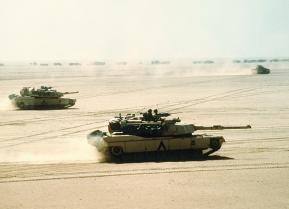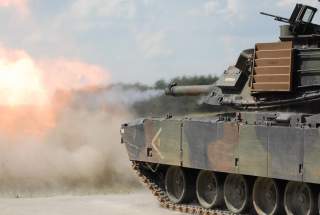How the Battle of 73 Easting Was Won
The Battle of 73 Easting was a great victory by the U.S. Army, validating the critical importance of having great leaders, solid institutional training, and premier combat equipment. We must always bear in mind, however, the permanent cost it often imposes on both the victors and the vanquished. Part two of a two-part series.
You can read part one here.
The initial attack on February 23, 1991, into Iraq had been anticlimactic. Intelligence had told us there would be various border outposts ready to attack us as soon as we penetrated their defenses. We fired hundreds of 155 millimeter artillery shells against their suspected locations in depth, but after we blew through the border, discovered only some goats and empty buildings. We knew the main line of defense was far to the north, so we continued moving.
From the 23rd to 25th of February we saw only sporadic fighting, lots of surrendering troops, and endless tracts of empty desert as our eyes grew red from the blazing intensity of the sun. The temperature in the Middle Eastern deserts can climb upwards of 130-degrees in the summer, but we were there in the winter and sometimes had frost on our tanks in the morning. As the sun went down on the night of February 25 we were greeted with a soaking, cold rain. Since I was the commander of my vehicle, I had to ride with the hatch open; there was nowhere to hide from the driving rain, and I was miserable.
By dawn the next morning, February 26, the rain had stopped but the clouds remained. As was our custom, we first sent our helicopters to screen about six miles in front of our lead scouts so that we would have the ability to develop the situation out of contact should we encounter major or unexpected enemy contact. But barely had we started that day when a sand storm came out of nowhere.
It was one of those storms of “biblical proportions” as they say, that was propelled by an intense wind which made the sand sting when it hit any exposed skin. The helicopters were quickly grounded, depriving us of our advanced warning and leaving our lead scouts as now the first line of defense. Because of the thickness of the sandstorm, our otherwise superior optics were rendered almost useless; we could barely see one hundred yards to our front by using goggles to protect our naked eyes. Some of the greatest advantages we held over the enemy had now been neutralized.
About 3 p.m. that afternoon, one of the scout leaders called me on the radio and said he saw something in his thermal sights but wasn’t sure what it was. Since my vehicle was just a few hundred yards from his Bradley, he asked me to take a look. I made the quick drive and jumped into his turret to look through the viewfinder. As soon as I did my eyes opened wide and I said I thought this was a line of dug-in enemy tanks. All we could see were “hot spots” on the reticles; the shapes weren’t readily identifiable. Based on how they were arrayed to the front, however, I suspected they were tanks dug into the ground so that only the turrets were visible.
I ran back to my command vehicle to radio the commander to report the sighting and request permission to engage with long range artillery. McMaster, however, had already been made aware of the “hot spots” and was in the process of giving instructions to Eagle Troop to maneuver on the spots. Initially he gave me permission to launch an artillery-fire mission (because there were no coalition forces in front of us: we were the front line of friendly troops and only enemy forces were in front of us). But cannons to the rear couldn’t process the mission fast enough and the order had to be scrapped because our own troops were advancing and might fall under our own bombs.
Because enemy contact was now likely, McMaster changed the formation and instead of leading with the lighter-skinned Bradley scouts, he moved the troop’s nine takes to move to the front. Macgregor had always told us that the safest place to be on the battlefield was in an M1 tank driving directly towards the gun tube of any enemy vehicle—the frontal armor of an M1 could defeat virtually any weapon Iraq had. McMaster knew this and put his strong armor in the lead.
Being true to his word that he would lead from the front, McMaster put his tank at the center of the formation and arrayed his two tank platoons in a “V” formation behind him in cascading rows to his right and left. Once in formation, he continued towards the suspected enemy locations and in the process his tank crested a small hill. As his tank treads hit the backside of the hill he discovered he was nearly gun tube-to-gun tube with eight Iraqi T72 tanks!
The M1A1 tank can hit a pinpoint target from over three miles away in the desert. That is the optimal engagement range because few Iraqi tanks could accurately fire to half that distance. McMaster, however, found himself within a couple hundred yards from the enemy! Immediately and simultaneously he ordered his gunner to engage the closest tank while McMaster got on the troop command net and screamed to the rest of us, “Contact! Tanks direct front!”
It was here for the first time that the years of training and preparation the 2nd ACR had done in Germany began to pay off. In the immediate recognition of enemy contact, there wasn’t time to figure things out; there was only time to react. Standard battle drills tell cavalrymen how to react to initial fire without the need to think. McMaster’s tank had one tank round in the gun and ready to fire. The gunner instantly squeezed the trigger before the commander’s words had all left his mouth and the first enemy tank exploded in a hail of fire and sparks.
The gunner then yelled out the type of shell he wanted and the loader, in three seconds, had it in the breach and ready to fire. Shifting immediately to the next closest target, the gunner yelled “on the way!” and another 120-millimeter sabot round was screaming at two thousand meters per second, slamming into the second T72, resulting in yet another massive explosion. Without waiting for any more instructions from McMaster, the gunner again yelled for a sabot round, and three seconds later, a third Iraqi T72 tank was shredded, sending the turret spinning into the air like a toy.
Recommended: Imagine a U.S. Air Force That Never Built the B-52 Bomber
Recommended: Russia's Next Big Military Sale - To Mexico?
Recommended: Would China Really Invade Taiwan?
Meanwhile, in the tanks to McMaster’s left and right, similar scenes were taking place. The battle drills for fire distribution called for the platoon on the right to observe the first enemy tank to explode and then attack the next one on its side, and the tank platoon on the left to do likewise. The results were stunning and spectacular: within eight seconds of first contact, eight Iraqi tanks were on fire. Not one of them had been able to get off a single shot in response.
Relieved of the immediate threat to his front, McMaster returned to the radio and began giving instructions to the remainder of the troops’ tanks and scouts and the attack continued with great ferocity and zeal. I was positioned between the left-most tank and the right-most Bradley scout and used my M60 machine gun to saturate everything between those two vehicles with 7.62mm bullets.
After the battle we counted over two hundred enemy dead, but to this day, I have no memory of seeing a single enemy troop as i fired belt after belt of ammunition. I don’t know if there just didn’t happen to be any troops in front of me—or if my mind somehow purged the images from my memory.
Macgregor, meanwhile, also made good on his promise to lead from the front—but almost took it too far. As the Squadron main effort was in the Eagle Troop zone, Macgregor positioned himself in his M1 command tank near my armored vehicle in the middle of our attack. I couldn’t initially distinguish his tank from the other Eagle tanks around me—until I heard one of the scout platoon leaders complaining over the troop command radio: “Black 6 (McMaster), this is Red 1,” Lt. Mike Petscheck said, “Can you get on (the squadron radio frequency) and ask Cougar 3 (Macgregor) to move? He’s masking our fires!”
The Squadron operations officer, the second in command of the whole operation, was in front of the leading scout section! There was no one in front of him except enemy tanks! One enduring image I have of Macgregor I will never forget, and I think perfectly exemplified the spirit of the cavalrymen in this fight.
Once he had repositioned so he wasn’t in front of Petcheck’s guns, I could see Macgregor’s silhouette sticking out of the commander’s hatch in the turret. I thought it odd that when we were engaging enemy tanks and machine gun bunkers that he was exposed in the turret instead of being “buttoned up” with the hatch closed.


